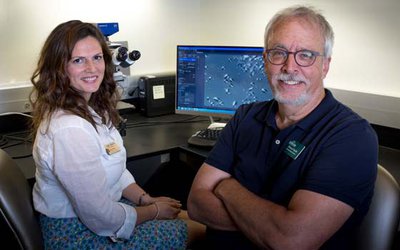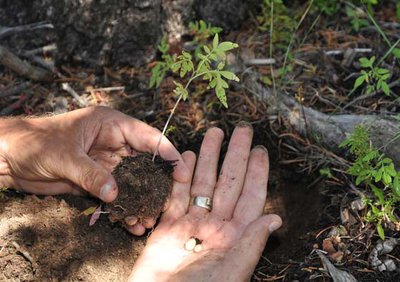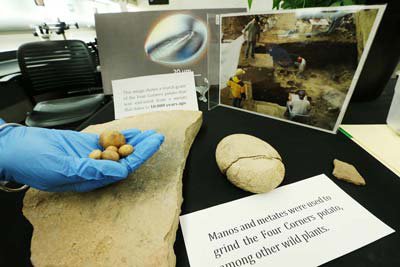
Categories



10,900 Year-Old Four Corners Wild Potato
Submitted: Sept. 27, 2017, 3 p.m.
This summer the Garden received a lot of press regarding a major discovery by our Red Butte Garden Plant Research & Conservation Department Director, Bruce Pavlik and Lisbeth Louderback, assistant professor of anthropology and curator of archaeology at the Natural History Museum of Utah
Together they discovered potato starch residues in the crevices of a 10,900-year-old stone tool from Escalante, Utah—the earliest evidence of wild potato use in North America. This is the first archaeological study to identify a species of potato native to the southwestern United States, Solanum jamesii, as an important food in 10,000-year-old diets.
Louderback and Pavlik pieced together evidence from stone tools, ethnographic literature and modern gardening to show that Utahans used the species for over 10,000 years.
Several Native American tribes, including Apache, Hopi, Kawaik, Navajo, Southern Paiute, Tewa, Zia and Zuni, consumed S. jamesii. The groups used various cooking and processing techniques, including boiling, grinding them into flour or yeast, and mixing the potatoes with clay to reduce bitterness. Some groups still tend potato populations in cultivated gardens.
The long history could mean that the species was transported, cultivated or even domesticated. If true, S. jamesii would be the first example of a plant domesticated in the western U.S. To find out, the researchers are collaborating with geneticists from the United States Department of Agriculture, who are mining S. jamesii's DNA for genes resistant to drought and disease that could be bred into current potato crops to make them more resilient.
"This potato could be just as important as those we eat today not only in terms of a food plant from the past, but as a potential food source for the future," says Louderback, senior author of the study published online on July 3 in the Proceedings of the National Academy of Sciences. "The potato has become a forgotten part of Escalante's history. Our work is to help rediscover this heritage." The Escalante area was previously known as "Potato Valley" to early settlers.
The potatoes we buy at the grocery store are all varieties of a single species, Solanum tuberosum, that was domesticated in the South American Andes more than 7,000 years ago. Since then, S. tuberosum has diversified into the reds, russets and thousands of other potato types for sale in markets around the world.
This new study deals with S. jamesii, a wild species found in the shady shelter of oaks, sagebrush and piñon pines across the Four Corners region of the southwestern U.S. Solanum jamesii, also called the Four Corners potato, is most abundant in the highlands of New Mexico, where its green leaves and delicate white flowers are scattered throughout piñon-juniper woodlands. In Utah, however, the plants only grow in sparse, isolated populations near archaeological sites, suggesting that ancient people carried the tubers to the area. Only five small populations of plants are known in the Escalante Valley, including one just meters from the North Creek Shelter archeological site.
The North Creek Shelter is one of Utah's oldest archaeological sites with an 11,000-year history. Ancient residents were mostly hunter-gatherers until the Fremont and Ancestral Puebloan cultures arrived and began cultivating crops. Today, the Southern Paiute reside in this region along with descendants of Mormon settlers. Our researchers enlisted the Escalante community to help conserve the plants and preserve their cultural heritage.
"It's hard to persuade the general public to care about rare plants. But this one has a real history associated with native people, with pioneers, with folks living though the depression and with the residents in Escalante today," says Bruce Pavlik, He added, "Across the range, it really should be treated as an antiquity, in a sense."
The discovery of S. jamesii consumption adds a new energy source that has been largely ignored in ancient diets, partly because tubers don't preserve well in archaeological deposits. Unlike animal bones and corn cobs, tubers are composed of soft tissues that disintegrate easily.
Louderback examined large sandstone slabs called metates and handheld grinding stones called manos, the ancient food processors on which people prepared meals. She found microscopic starch granules that previous archaeologists never suspected were present.
"Grinding plant tissues with manos and metates releases granules that get lodged in the tiny cracks of stone, preserving them for thousands of years. Archaeologists can retrieve them using chemicals, modern microscopy and advanced imaging techniques," says Louderback.
All starch granules have concentric circles that grow outward like tree rings. The origin of growth begins with what's called the hilum. The majority of plant species have starch granules with hila at the center of the grain. However, the hila of granules filling Louderback's microscope slides were off-center. Only a few species from the Four Corners region produce starch granules with that specific characteristic; S. jamesii is one of them.
Louderback and NHMU postdoctoral research associate Nicole Herzog, now a lecturer at Boise State University, analyzed granules from modern-day S. jamesii to establish a set of five characteristics that accurately identified the wild potato, starting with the off-center hilum. Starch granules with five out of five characteristics were a verified wild potato. They analyzed tubers from three different modern populations, 100 granules per tuber.
Louderback and Pavlik checked for the characteristics on granules found on the ancient stone tools from North Creek Shelter. Out of the 323 total starch granules, 122 had the off-center hilum. Of those, nine were verified S. jamesii and another 61 were either likely or possibly S. jamesii.
The researchers are collaborating with colleagues from the USDA Potato Gene Bank, who have studied the genetics of S. jamesii since the 1990s. Future efforts will focus on understanding patterns of genetic diversity across the Four Corners region to look for clues about whether the tubers were transported, manipulated or even domesticated.
The researchers want to make the potatoes available for the Escalante community to grow in their gardens to help with conservation. But first, they need to untangle the mysterious ecology of the potato in the wild—its pollinators and conditions necessary for reproduction are still unknown. "We are working with the people of Escalante to bring awareness to this valuable resource and show them what the species looks like, where it grows, its tremendous history and enlist their help as stewards of the Four Corners potato," says Pavlik.